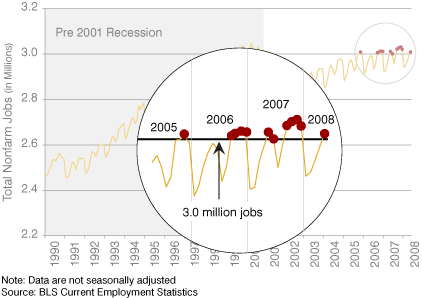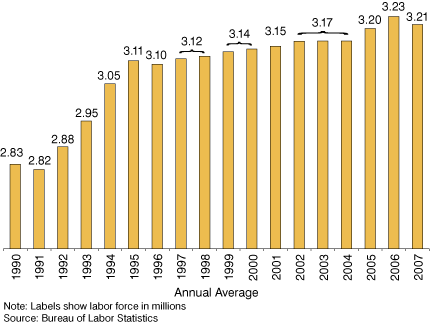On Labor Force, Employment and Jobs
Amid the disasters of floods and tornadoes, the ever fluctuating price of oil, and the continuing financial shocks centered on Wall Street, Indiana has marked some significant employment milestones that bear noting and watching.
Milestone 1
Since the well-publicized pre-recession peak in May 2000, Indiana has had more than 3 million jobs in its economy 12 times since the recession in 2001—most recently in May of this year (see Figure 1). To view volume, we are considering the estimate in absolute terms (and not with adjustment for seasonality, which can mask the actual "volume" of jobs we seek to measure here).
Figure 1: Job Peaks in Indiana, 1990 to May 2008

Milestone 2
The second milestone was topping 3.28 million people in our labor force in July, an important measure for businesses looking for places to locate with ample labor supply (see Figure 2). Of those 3.2 million residents, nearly 3.1 million were employed as of July 2008.
Figure 2: Indiana's Labor Force, 1990 to 2007

Worth watching: the strong trend we observe in the data to hover close to and in some months go over the 3 million job mark. As always, we will monitor these and other economic measures within the pages of InContext.
Okay, Some Definitions Are in Order
Jobs are held by people, but aren't a count of people. One way to consider this is that you have two jobs, an astronaut by day and an EMT by night. You are one person, but you have two jobs. So we call the "employment by place of work" number jobs. Monthly job counts are tracked by the Current Employment Statistics of the Indiana Department of Workforce Development and the U.S. Bureau of Labor Statistics and are often referred to as CES. The CES numbers published at the national and state level are available with or without adjustment. This article focuses on not-seasonally adjusted numbers so as to capture the volume of jobs, as mentioned above.
How many people are working or are available to work is also important to measure. The federal definition of the resident labor force is the number of people working and those who are without a job but actively seeking work. This is a people number—you either work or you are actively seeking work in order to be part of this number. The figures are part of the resident labor force estimates, which are also put out monthly by the Indiana Department of Workforce Development and the U.S. Bureau of Labor Statistics. These estimates are sometimes referred to as the LAUS numbers and yield the well-monitored unemployment rate. There is more to these estimates than the rate—these numbers represent people in our state who work or want to work and, once again, measure the size of our labor force.
Carol Rogers, Deputy Director
Indiana Business Research Center, Kelley School of Business, Indiana University
